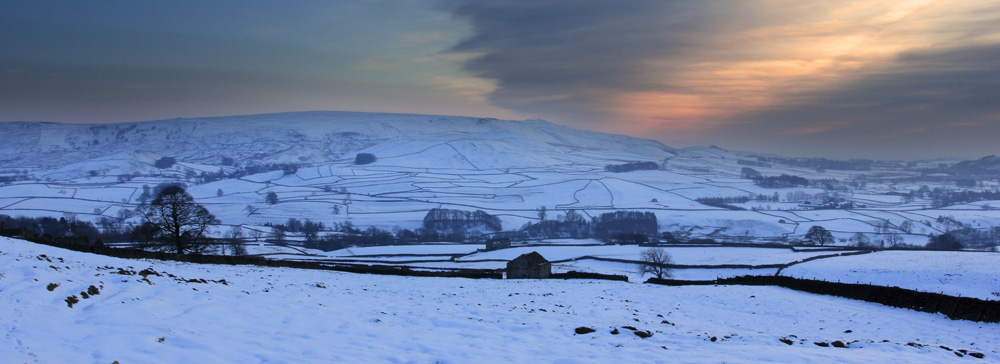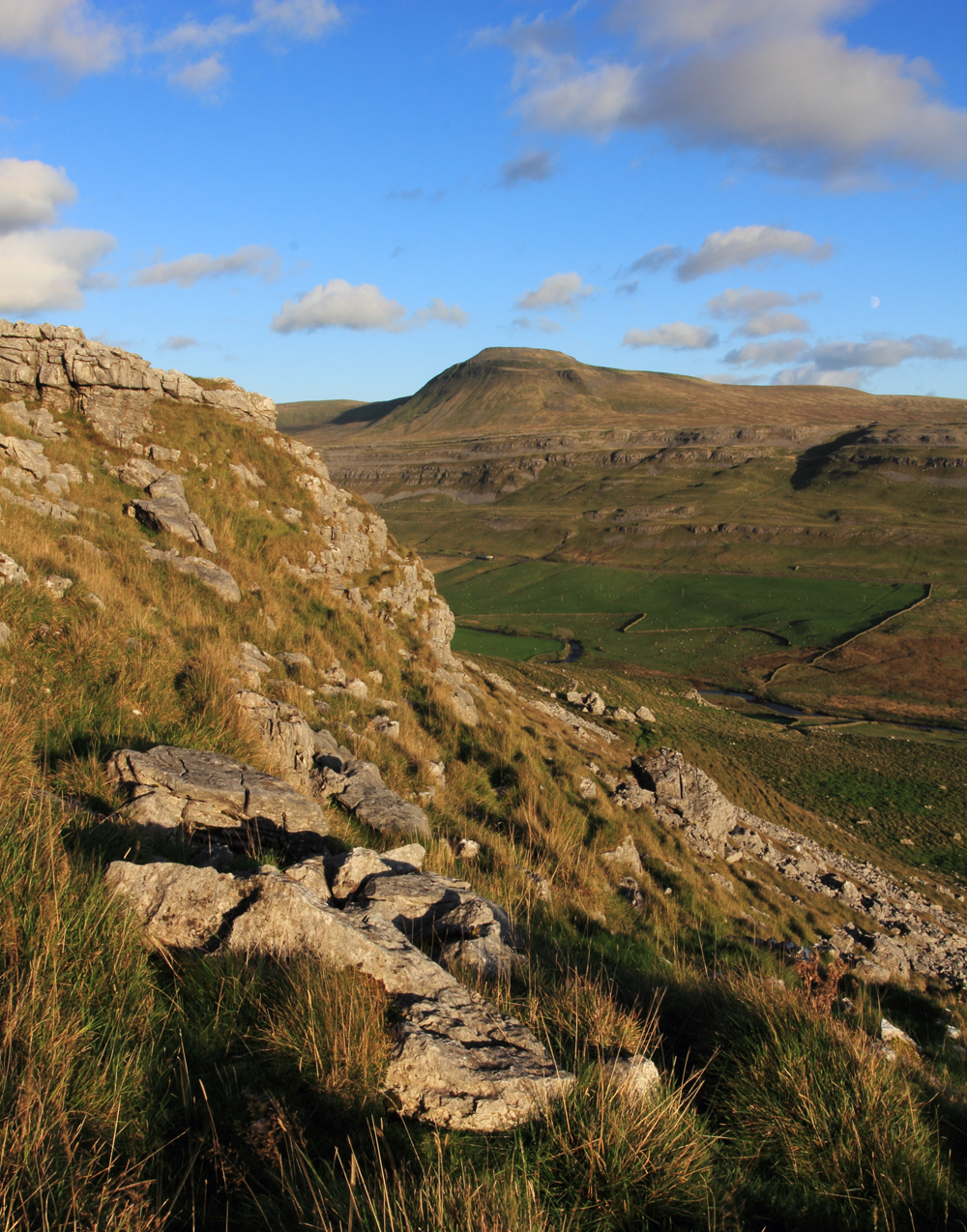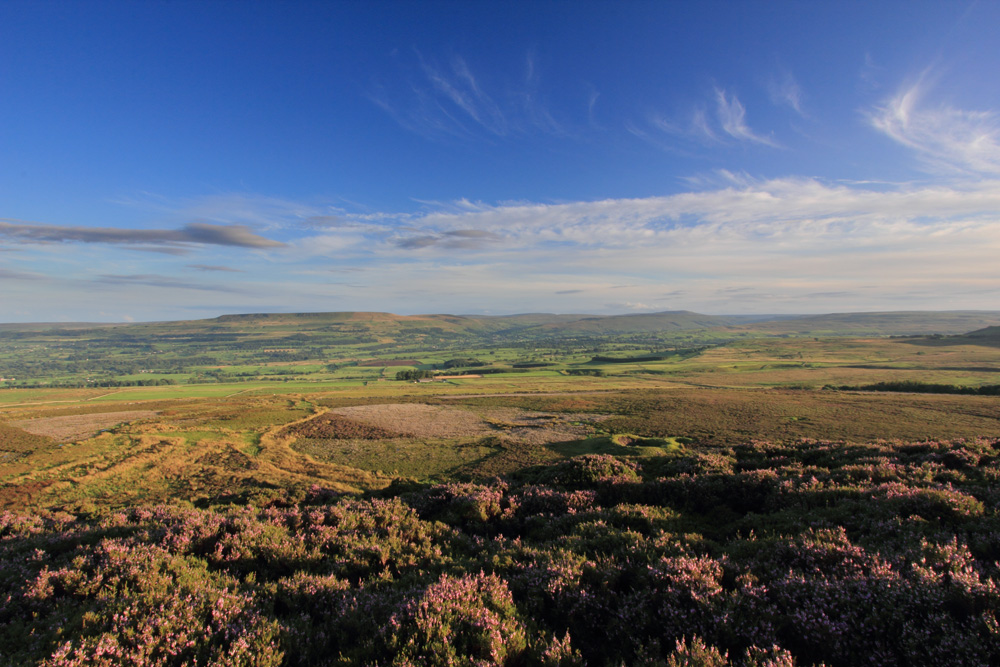
 Jane Le Cocq – Farm Conservation Adviser, Yorkshire Dales National Park Authority
Jane Le Cocq – Farm Conservation Adviser, Yorkshire Dales National Park Authority
This view is taken from the top of Widdale Fell, with Dent and Garsdale in the distance. This is a farm I was doing a survey on in 2011. It was a hard slog up to the top of Widdale Fell. It was a really clear day and you could see all the Lakeland hills in the distance. I walked across the top of the fell and suddenly came across this fantastic tarn. The water was really, really still, like a millpond, and I just thought, ‘Wow!’ – it was so unexpected.
The top of Widdale Fell is heath. There was quite a bit of blanket bog: deep peat which supports plants like heather and cotton grass. That was basically what I was going up there to survey. Down here (just behind where the picture’s taken) I found the ruins of a little shepherd’s hut, which had a tiny fireplace in the corner of it – it was really lovely. It is high up there, and you can just imagine them on a night, huddled round a little fire while it’s blowing a gale.
I’m a Farm Conservation Adviser. Part of my job is to help farmers get into Higher Level Stewardship. In order to do that they have to have a survey done of the whole farm. You have to record every feature, whether it’s moorlands, meadows, woods, barns, walls – everything. It’s all done on foot, with a map, just marking down as you walk everything that’s there; the type of habitat; what condition it’s in; and what they could do to improve it for various species.
This farm has been in Stewardship for quite a number of years. Before they went into Stewardship there was a lot of exposed peat, and not much heather, possibly due to the number of sheep being grazed. When sheep graze, the heather, cotton grass and other small herbs get eaten out. It’s replaced by rough grass, so other species miss out. If the peat’s exposed it leads to a lot of erosion, and then you’re losing carbon, because peat bogs are a vital carbon sink – comparable to forests even. The environmental schemes help to compensate farmers for reducing or taking stock off those areas.
Now up here the exposed peat is revegetating. There’s red and black grouse and other moorland birds, lots of diversity in the sward itself: lots of little herbs and rare bog plants like sundews – which sound boring, but they’re not really!
I’ve always been interested in wildlife and nature. I used to be a veterinary nurse. I lived in the Channel Islands for years, but when we came back to Yorkshire I had to do something different, because the veterinary nursing didn’t fit in with family and lifestyle. I retrained, and over quite a few years took a degree in environmental conservation. And then luckily a job came up here, which I got, in 2005.
I grew up in Otley. We had relatives up in the Dales so I knew it really well. I used to be a volunteer here at the Park when I was a teenager – I always dreamt about working in the Dales.
I like everything about my job. I like being able to get out and go to places which you’d normally never get access to. I like the diversity – you do a bit of ecology; a bit of woodland management; I’m really interested in vernacular architecture so that fits in really well too. I like meeting the farmers.
We have a family farm with suckler cows. Because I’ve got a veterinary nursing background, I do all that type of thing, and also paperwork and admin. I love it. It’s also good because in my work I can see things from both sides. My sons are not at all interested in conservation and would be happy with acres and acres of ryegrass!
A lot of my job is trying to illustrate to farmers that they wouldn’t necessarily be losing out economically, and in some cases they might be better off in Stewardship, because they know they’ve got a set income for ten years. And when you show farmers what they’ve got on their farms in terms of biodiversity and historic features, a lot of them are really interested. Often they haven’t seen it in those kinds of terms before – they’ve just seen it as somewhere to raise livestock. But because the species and habitats wouldn’t be there without farmers managing the land for livestock production, it’s important that that management carries on.
View 8
 We often take the landscape around us for granted. We might appreciate a view for its beauty, but not think to consider the natural and historical processes, or the everyday work and care that goes into managing and sustaining it. Working The View explores this relationship between the landscape of the Yorkshire Dales National Park and its guardians; bringing to light the work that goes on to protect, enhance and make a living from it.
We often take the landscape around us for granted. We might appreciate a view for its beauty, but not think to consider the natural and historical processes, or the everyday work and care that goes into managing and sustaining it. Working The View explores this relationship between the landscape of the Yorkshire Dales National Park and its guardians; bringing to light the work that goes on to protect, enhance and make a living from it.

















